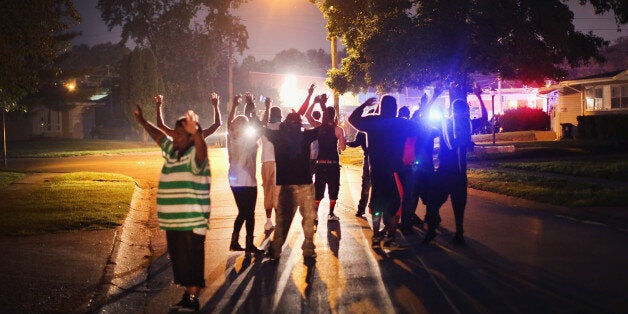
Another day, another unarmed black man killed by police. We grieve their loss and pray God's strength for their families:
Eric Garner, 43, strangled to death on a Staten Island sidewalk.
John Crawford, 22, shot to death in a Beavercreek Walmart.
Michael Brown, 18, shot to death, reportedly with arms raised, on a Ferguson street.
How often must we drink from this bitter well?
The disturbing nature of the frequency of recent news reports in which unarmed Black men have been killed by law enforcement officers is only exceeded by this fact: the act itself is deeply embedded into the racial fabric of our nation. Fifty years removed from the Freedom Summer murders of James Chaney, Andrew Goodman, and Michael Schwerner -- a conspiracy allegedly enacted by Neshoba County sheriff Lawrence A. Rainey -- we still face the difficult reality that for generations unarmed Black men have met their demise at the hands of those sworn to serve and to protect all citizens.
On the night of June 21, 1964, a year after the brutal assassination of Medgar Evers, three courageous young men were also killed in Mississippi. The two white men, Goodman, 20, and Schwerner, 24, died of a single gunshot wound to the heart. The lone Black man, Chaney, 21, was tortured, then tied to a tree and beaten with chains, before ultimately being shot three times. Here, even amid brutalities, a clear distinction was made concerning the value of Black life, the white lives ended immediately, with diabolic mercy, the Black life made to suffer greatly before finally being terminated. In the search for these three men after their disappearance, eight more Black bodies were found having been discarded like rubbish across Mississippi lakes, forests, and plains. Undoubtedly, law enforcement had a hand in these deaths as well, Sheriff Rainey notorious for intimidating and killing Blacks.
Mine is not an indictment of all police officers. There are many men and women who put their lives on the line for the public good each day. Some I have been blessed to call mentor or friend. Many officers themselves have lost their lives. I honor their memories and ultimate sacrifice even as I offer gratitude for those who continue to work with great integrity to keep us safe.
Yet, unquestionably, there is cause for great concern as I believe that a critical mass of law enforcement officers find Black lives expendable. Towards this, I see this likely cause: there is a racially-motivated culture of fear that over-assigns threat to Blacks, especially, but not exclusively, to Black males, even when no justifiable threat is present. Recent findings from the American Psychological Association supports this fact stating, "Black boys as young as 10 may not be viewed in the same light of childhood innocence as their white peers, but are instead more likely to be mistaken as older, be perceived as guilty and face police violence if accused of a crime."
Historically, Black bodies have been considered expendable and easily replaceable. Tens of millions of Africans were brought to this nation as slaves because Black life was considered expendable. If an African became gravely ill or died while in forced voyage to the "New World," they were just thrown into the sea. While Black life was considered expendable, and the supply of other Africans on the continent was considered inexhaustible. Other Black bodies would substitute for any losses in future voyages.
During American slavery, Black babies and children were used as bait to lure alligators from the swamps for capture. This sometimes resulted in the maiming or death of these Black children because Black life was considered expendable. The United States Public Health Service used Black men to test the impact of untreated syphilis from 1932-1972 resulting in the death of many Black men and in the infection of their partners because Black life was considered expendable.
Environmental racism places the urban poor near landfills and factories that cause increased rates of cancer and other diseases because Black, and even poor lives, are considered expendable. Levies in New Orleans were poorly maintained and constructed near poor Black communities resulting in massive flooding after Hurricane Katrina because Black lives are considered expendable. Blacks receive harsher penalties for the same crimes, and, according to a recent Stanford University report, the disproportionate rate of Black imprisonment may actually encourage white support of racially-driven tactics such as stop-and-frisk because Black lives are considered expendable.
The expendability of Black life also extends to our national foreign policy. America's response to acts of genocide, religious persecution, and the spread of infectious disease on the continent of Africa today is oft times delayed, if acted upon at all. When it comes to foreign policy, African Black lives are especially considered expendable, their difficulties rarely considered our priority.
Of course, Black life is not expendable! No life is, for all life has great value. Yet, the treatment of Black life as expendable reveals our deep and abiding malfeasance. We often fail to see the face of God in the face of our neighbor, especially if that neighbor is darkly pigmented. Since all human life was created in the image of God, we are guilty of no less than the desecration of God's image when we ignore the brutalization of our neighbors, who we are commanded to love as ourselves (Mark 12:31).
It was while traveling the road to Damascus that Saul had an encounter with the resurrected Christ, himself a victim of fatal brutalities at the hands of law enforcement. To Saul, Jesus posed this powerful inquiry; "Why are you persecuting me?" (Acts 9:4)
For the recently fallen, Jesus surely weeps and asks his question, anew; "Why are you persecuting me?" Maybe it is because we see Christ as we increasingly see each other, and Black life; as expendable.
